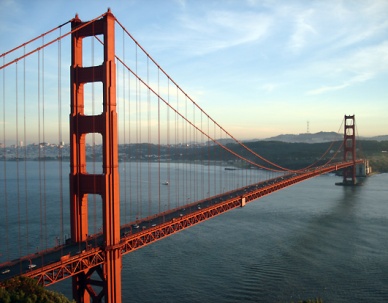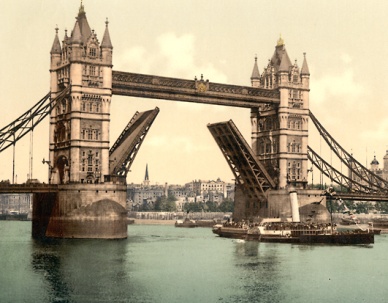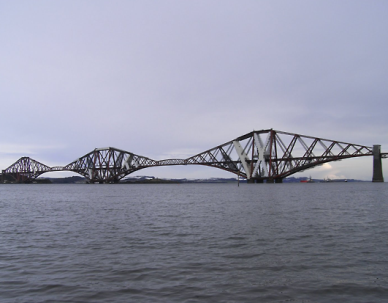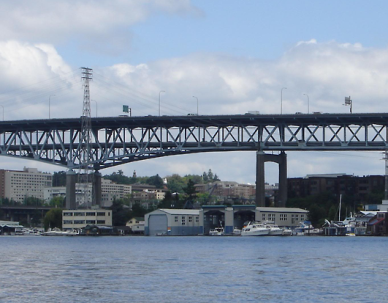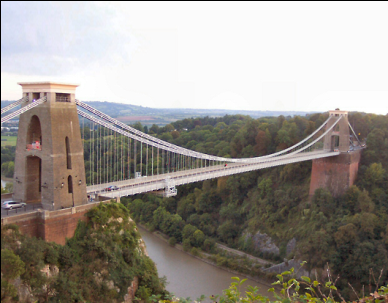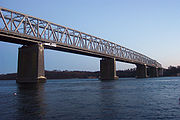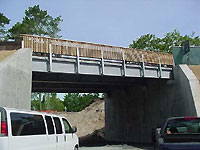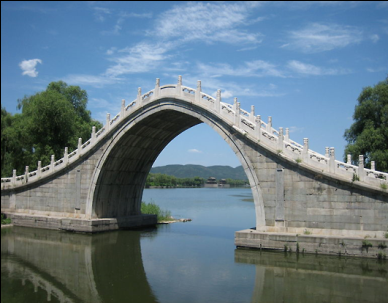Учебное пособие. А. Н. Туполева (каи) кафедра восточных и европейских языков (вея) engineering английский язык для студентов технических специальностей учебное пособие
 Скачать 7.94 Mb. Скачать 7.94 Mb.
|
2. TYPES OF BRIDGESLook at the pictures of bridges below. Read the text below the pictures. Match the pictures (a-h) to the types of bridges (1-8) mentioned in the text.
There are many different types of bridges. The classification is based on the purpose of usage, bridge dimensions, structure of the bridge, the material used in the construction, etc. Sometimes a bridge belongs to more than one type. The most commonly used are the following types: 1) Beam bridges Beam bridges are horizontal beams (= girders) supported at each end by piers. The earliest beam bridges were simple logs across streams and similar simple structures. In modern times, beam bridges are large box steel girder bridges. Weight on top of the beam pushes straight down on the piers at either end of the bridge. They are made up mostly of wood or metal. Beam bridges typically do not exceed 250 feet long. The longer the bridge, the weaker it is. 2) Cantilever bridgesCantilever bridges are built using cantilevers—horizontal beams that are supported on only one end. Most cantilever bridges use two cantilever arms extending from opposite sides of the obstacle to be crossed, meeting at the center. The largest cantilever bridge is the 549-metre (1,801 ft) Quebec Bridge in Quebec, Canada. 3) Arch bridgesArch bridges are arch-shaped and have abutments at each end. The earliest known arch bridges were built by the Greeks and include the Arkadiko Bridge. The weight of the bridge is thrust into the abutments at either side. Dubai in the United Arab Emirates is currently building the Sheikh Rashid bin Saeed Crossing which is going to be completed in 2012. When completed, it will be the largest arch bridge in the world. 4) Suspension bridgesSuspension bridges are suspended from cables. The earliest suspension bridges were made of ropes or vines covered with pieces of bamboo. In modern bridges, the cables hang from towers that are attached to caissons or cofferdams. The caissons or cofferdams are implanted deep into the floor of a lake or river. The longest suspension bridge in the world is the 12,826 feet (3,909 m) Akashi Kaikyo Bridge in Japan. 5) Cable-stayed bridgesLike suspension bridges, cable-stayed bridges are held up by cables. However, in a cable-stayed bridge, less cable is required and the towers holding the cables are proportionately shorter. The first known cable-stayed bridge was designed in 1784 by C.T. Loescher. The longest cable-stayed bridge is the Sutong Bridgeover the Yangtze River in China. 6) Truss bridgesTruss bridges are composed of connected elements. They have a solid deck and a lattice of pin-jointed or gusset-joined girders for the sides. Early truss bridges were made of wood, and later of wood with iron tensile rods, but modern truss bridges are made completely of metals such as wrought iron and steel or sometimes of reinforced concrete. The Quebec Bridge, mentioned above as a cantilever bridge, is also the world's longest truss bridge. 7) Movable bridgesSome bridges are not fixed crossings, but can move out of the way of boats or other kinds of traffic which, ideally, moves under them, but is sometimes too tall to fit. These are generally electrically powered. 8) Double-decked bridgesDouble-decked or double-decker bridges have two levels, such as the San Francisco – Oakland Bay Bridge, with two road levels. Tsing Ma Bridge and Kap Shui Mun Bridge in Hong Kong have six lanes on their upper decks, and on their lower decks there are two lanes and a pair of tracks for MTR metro trains. Likewise, in Toronto, the Prince Edward Viaduct has four lanes of motor traffic on its upper deck and a pair of tracks for the Bloor–Danforth subway line. Some double-decker bridges only use one level for street traffic; the Washington Avenue Bridge in Minneapolis reserves its lower level for automobile traffic and its upper level for pedestrian and bicycle traffic (predominantly students at the University of Minnesota). Robert Stephenson's High Level Bridge across the River Tyne in Newcastle upon Tyne, completed in 1849, is an early example of a double-deck bridge. The upper level carries a railway, and the lower level is used for road traffic. Another example is Craigavon Bridge in Derry, Northern Ireland. The Oresund Bridge between Copenhagen and Malmö consists of a four-lane highway on the upper level and a pair of railway tracks at the lower level. The George Washington Bridge between New Jersey and New York has two roadway levels. A truss work between the roadway levels provides stiffness to the roadways and reduced movement of the upper level when installed. Tower Bridgeis another example of a double-decker bridge, with the central section consisting of a low level bascule span and a high level footbridge. Read the text again and find the answers to the following questions:
|

